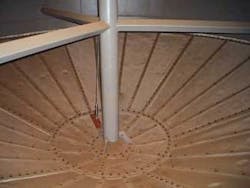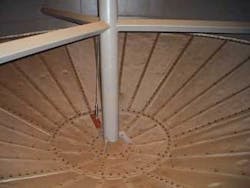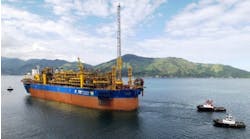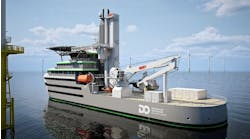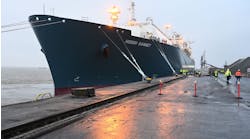CARGO HANDLING: Supply vessel bulk handling system provides space/energy benefits
A dry bulk handling system on order for a new design of platform supply vessel incorporates numerous features that improve efficiency, in terms of space usage, energy consumption, and the level of automation integrated into the vessel’s central cargo control system.
A dry bulk tank incorporating HW Carlsen’s fluidized floor.
The HW Carlsen-supplied equipment has been ordered by Damen Shipyards in the Netherlands for two of its PSV 7216 design vessels currently under construction at its yard in Galati, Romania. Both are due to be delivered next year to the Dutch company, Vroon Shipping.
According to HW Carlsen’s general manager, Cornelius Schouten, the total dry bulk capacity of its systems on these vessels will be 260 cu m, with a discharge rate of 75 cu m/hr. A dust collection method prevents the escape of dust from the vent lines into the environment.
The compressor system includes refrigerated air dryers to prevent humidity problems that could impact the quality of the dry bulk material. The compressors are frequency controlled, allowing a slow start and enabling substantial savings to be made on energy consumption.
Space, steel savings
The company’s pioneering advances in dry bulk handling could benefit a wider range of supply boats, Schouten believes. “It’s surprising the offshore industry still uses pressure tanks, considering the amount of space they occupy,” he says. A supply boat with pressure tanks effectively uses only one third of the gross volume occupied by the whole installation for the actual net cargo.
Drawing on HW Carlsen’s experience as a specialist in self-discharging systems for cement carriers, Schouten suggests that net cargo volume could be doubled through the use of its vacuum/pressure system. This involves a fluidized floor in the hold which enables the dry bulk material to be fluidized by blowing air underneath it. The floor is angled so that the fluidized material flows towards a central point where it is picked up by the pneumatic or mechanical conveying system.
HW Carlsen has extended its thinking to semisubmersible rigs, where the pressure tanks used for storing, for example, barite, bentonite, and cement could be replaced by silo-bins incorporated in the steel structure, in one of the columns. From there, the material could be discharged via small-size sender tanks directly to the surge tanks and mud mixer. For a typical drilling rig, in addition to the space saving, this would allow a substantial amount of steel to be saved in the rig construction, Schouten claims.
The proposal has interested several owners, and this summer the company was negotiating to supply such a system to a newbuild rig project.
For more information contact Cornelius Schouten, HW Carlsen. Tel +46 40 690 3300, fax +46 40 690 3399,[email protected], www.hwcarlsen.com
